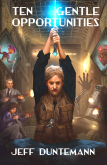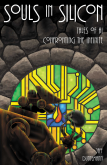Here’s another bunch, some from me, some from readers. Time passes. The world changes. More and more, the world that’s vanishing is the one we grew up in.
- Mechanical charge-card imprinters. You know, when charge cards used to have embossed numbers, and the store clerk would put your card down and a 3-carbon slip over it, and go snick-snick to transfer the embossed card number onto the charge slip. I haven’t had an embossed card for quite a few years, so these are well and truly gone.
- Pocket radios. I still have a couple of these, but I don’t remember when I last listened to any of them. Carol and I have had a “kitchen radio” (the solid state successor to the archetypal “All-American Five”) for over forty years. It’s in the kitchen. It doesn’t get much use.
- 4:3 computer monitors. Although you can get them used on EBay, the canonical 4:3 aspect ratio flat-screen monitor is long out of production. I have several, but if they ever flake out on me I suspect I’m going to buy a big-ass 9:16 and force myself to get used to it.
- Churchkeys. And by that I mean the kind with two ends: One to pop the tops from soda/beer bottles, and the other to poke triangular holes in soda and beer cans. Cans are all pull-tab now, and it’s only imported sodas (and some beers) that need a churchkey to open.
- Rolodexes. I still have one, and I still use it to keep significant business cards within easy reach. However, I’m pretty sure that my generation will be the last to use them on a daily basis.
- Green River soda. This was and would probably remain my all-time favorite soda—if I could still get it. We used to buy it at a quirky grocery store near our condo in Des Plaines IL. They had regular and diet, both in glass bottles and in 2-liter plastic bottles. I used to get the 2-liter diet sku, which I haven’t seen since we sold the condo in 2015. It still exists (and has its own web page) but can mostly be found in quirky little grocery stores in or near Chicago.
- In-house intercoms. The 1958 house Carol grew up in had one. Ours (1949) did not. The new house we bought here in AZ in 1990 had one, and that’s as recent as I’ve seen one. My folks had a Talk-a-Phone intercom put in when my sister was born, and for awhile it was a baby monitor. I took the two units apart circa 1969.
- Dehumidifiers. These generally sat in the basement, and a refrigerated coil of aluminum tubing would condense all that Chicago humidity into drips that gathered in a pull-out well in the bottom. These may still be in use in humid climates; needless to say, they aren’t necessary in Arizona.
- Superballs. Again, these may still exist, but I’ve never seen one recently like those we used in the mid-1960s: Their surfaces were under considerable tension, and even a tiny scratch would spread into a crack. Eventually they just split into chunks. But damn, those things bounced high.
- Pocket calculators. When every smartphone is a pocket calculator, there isn’t much call for standalone pocket calculators. I still have my late ‘70s red-LED TI Programmer, and my 1982-ish TI-30 SLR.
- Slot cars and retail slot car tracks. Bill Beggs reminded me of slot cars, which were never an interest of mine but in their heyday were a very big thing. There was a storefront slot-car track less than a mile from where I grew up, on Devon in Park Ridge. Long-gone. Still with us, however, is Dad’s Slot Cars in downtown Des Plaines, just outside Chicago. Fifteen years or so ago they added an ice-cream parlor at the back of the storefront. It’s only open on weekends now, but there must be slot car fans somewhere or it would not be open at all.
- Car CD players. My 1996 Jeep Cherokee was the first car I had that came with a CD player. The 2001 4Runner we bought not only had a CD player but a CD changer that could play six CDs without needing to reload. By the time we bought our 2014 Durango, the CD player had been superceded by the now-ubiquitous USB port and thumb drive player in the console.
- Rear-projection TVs. We bought one of these just before Christmas 2005, and used it until something inside it fizzled out and died in 2012. The picture, while big, was never exceptionally sharp, and once LED panels could be mass-produced in 56” (or more) diagonal sizes, rear projection died in a hurry. I had to pay $75 to a recycling company to get rid of it after it croaked.
- Pastel-colored toilets. These were huge in the late 1950s. Carol’s childhood home (1958) had three bathrooms, each with a toilet/sink of a different color. I believe we added a pink toilet and sink when my folks had a second bathroom put in in 1957. You can still get them, but they are now Midcentury Modern retro exotica.
- Pastel-colored Kleenex. This was common through the 1970s and then started getting scarce. Carol and I passed a light blue tissue between us as we knelt on the prie deux during our wedding mass in 1976, alternately mopping our eyes.
- Paper encyclopedias. My family bought the 1958 Encyclopedia Britannica. It was wonderful. Carol and I bought the 1974 edition shortly before we married in 1976. I read it a lot until the Internet happened, and then little by little Alta Vista searches (and later Google) made research a whole lot easier. We sold it to the people who bought our Colorado house when we moved back to Arizona in 2015. The leather bindings were drying out and cracking, and in truth we went years between sessions with it. I’ve heard they’re now “shelf candy,” and can be rented to stage houses.
- Dollar coins. Half-dollar coins died about 2001, though the US Mint struck collectables for a few years thereafter. Just to be perverse, I asked my bank for a few Sacajawea dollar coins circa 2012 and spent them. Older cashiers just grinned. Young people at the register looked hard at them. But really: When was the last time you handled or spent one?
- Horse racing. Like slot cars, I’ve never been interested in horse racing, but Rich Rostrom told me that the Chicago Bears bought Arlington Park racetrack, had the grandstands demolished, and may be planning a new football stadium there. Apparently horse racetracks are shutting down all over the country.
- Smoking pipes. (And I don’t mean crack pipes, or anything else in the line of drug paraphernalia.) This again came from Rich Rostrom, and he’s right. My father had a pipe but I never saw him smoke it. A friend and I tried to smoke marijuana in a cheap pipe in 1971, and mostly failed. I truly don’t remember the last time I was in the presence of a pipe smoker.
- Stove-top percolators. (This from Bill Beggs.) When I was a kid, my folks used a beat-up aluminum percolator to make their coffee. Mr. Coffee drove percolators off the edge of the world, and I think Mr. Coffee is now being shoved toward the same abyss by K-machines. I now mostly buy my coffee at McDonald’s.



















